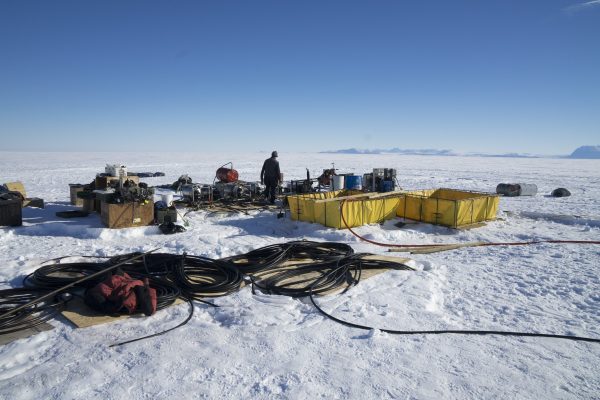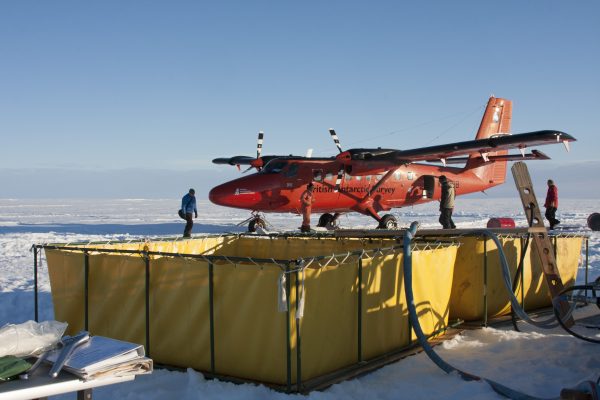UAF scientists will help gauge how Antarctic glacier could collapse
April 30, 2018
Sue Mitchell
907-474-5823

University of Alaska Fairbanks researchers will take part in an international collaboration to understand when Antarctica's Thwaites Glacier will begin to collapse and drive up global sea levels.
The $25 million joint U.K.-U.S. research program launched Monday, April 30, is one of the most detailed and extensive examinations of a massive Antarctic glacier ever undertaken.
Scientists will gather the data needed to understand whether the Thwaites Glacier’s collapse could begin in the next few decades or centuries.
The U.K. Natural Environment Research Council and the U.S. National Science Foundation have funded eight large-scale projects that will bring together leading polar scientists in one of the most inhospitable regions of the planet. The program, called the International Thwaites Glacier Collaboration, is the largest joint project undertaken by the two nations in Antarctica since the late 1940s. These projects aim to answer some of the big questions for scientists trying to predict global sea-level rise.

UAF associate professor Erin Pettit, of the College of Natural Science and Mathematics, is the principal investigator for one of the eight projects. The Thwaites-Amundsen Regional Survey and Network, or TARSAN, will investigate how the ocean and atmosphere are affecting the glacier.
Pettit will work with professor of physics Martin Truffer, of the UAF Geophysical Institute, and Karen Heywood, of the University of East Anglia. They will measure ocean circulation and thinning beneath the floating part of the glacier using such state-of-the-art technology as autonomous underwater vehicles and automated land-ice stations.
The collapse of the Thwaites Glacier in West Antarctica could significantly affect global sea levels. It drains an area the size of Florida.
“This is the most vulnerable ice in the world,” said Truffer. “If the Thwaites sector melts, there could be about 5 feet of global sea level rise” from it.
Pettit said melting of the Thwaites Glacier is the most likely source of sea-level rise during the next 30 years.
"It’s one thing if we say it will melt in 1,000 years; it’s another if it’s 100 years," she said. "There’s a lot of money involved in a rise of just a few centimeters in sea level.”

South Korea, Germany, Sweden, New Zealand and Finland also will contribute to the various projects.
The nearest permanently occupied research station to the Thwaites Glacier is more than 1,000 miles away, so getting the scientists to where they need to be will take a massive joint effort from both nations. While researchers on the ice will rely on aircraft support from U.K. and U.S. research stations, oceanographers and geophysicists will approach the glacier from the sea in U.K. and U.S. research icebreakers.
“Satellites show the Thwaites region is changing rapidly," said William E. Easterling, assistant director for the NSF Geosciences Directorate, "but to answer the key questions of how much, and how quickly sea-level will change in the future requires scientists on the ground with sophisticated equipment collecting the data we need to measure rates of ice-volume, or ice-mass change. The challenges of conducting fieldwork of this scope and scale in such remote locations are enormous. The only practical way for nations to do this is to work collaboratively, each bringing their resources, both scientific and logistical, to enable complex and comprehensive field studies.”
Preparation for the five-year program will begin in October 2018 with the deployment of fuel and supplies, and establishment of field camps on Thwaites Glacier by logistics teams from the U.S. Antarctic Program and British Antarctic Survey. The science program will begin in 2019-2020 and continue to 2021.
The science activities and information gathered will be disseminated through several outreach and media-aimed efforts in the U.K. and U.S. and with websites and blogs. The data gathered by the International Thwaites Glacier Collaboration will be archived and freely shared at the end of the program to help understanding of the area.
ADDITIONAL CONTACTS: Erin Pettit, ecpettit@alaska.edu; Martin Truffer, mtruffer2@alaska.edu, 907-474-5359; Peter West, National Science Foundation, pwest@nsf.gov, 703-292-7530


